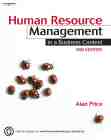Employee relations
 Introduction
Introduction
This section examines the nature of employee relations within the framework
of HRM. It looks at the roles of trade union,
and legislation.
Employee relations is not confined to unionized collective bargaining but
encompasses all employment relationships. It goes beyond the negotiation
of pay and benefits to include the conduct of the power relationship between
employee and employer.

TUC General Secretary Brendan Barber is challenging Britain's
politicians to produce an agenda for human resource management in the workplace and recognise the positive role that
unions play in promoting social justice and securing economic advance.
 You can agree or disagree with the content but a speech by
Tony Abbott at the end of 2001 provides a useful insight into the Federal Government's industrial relations
strategy. On HRM Guide Australia.
You can agree or disagree with the content but a speech by
Tony Abbott at the end of 2001 provides a useful insight into the Federal Government's industrial relations
strategy. On HRM Guide Australia.
 A Conference Board report - - looks at negotiations in Canada during 2003.
A Conference Board report - - looks at negotiations in Canada during 2003.
 Collectivization and confrontation
Collectivization and confrontation
The employment relationship
is a problematic one. Regarded by neo-classical economists as an exchange
of labour for pay, it is also a power relationship in which the employer
has the formal authority to direct effort towards specific goals, whereas
the employee can - informally - frustrate the achievement of those objectives
(if they so choose). In the past, 'industrial relations' has been associated
with conflict between trade unions and employers and conveys a picture
of acrimonious strikes and lock-outs.
There are significant differences in union density (proportion
of the workforce who were trade union members) between Canada and the USA, and
also between and within industry sectors in the United States. In the period 1950-2001 union density in Canada fluctuated in the range around 32-37%, with a
marked drop between top and bottom of this range between 1995 and 2001. By contrast, there
was a consistent drop in US union density between 1960 and 2002, down from comparable levels to those in
Canada to a mere 13.2% (16.1 million workers) in 2002.
Why is there such a difference? The prevailing view (see Johnson, 2002)
is that mandatory voting has discouraged unionization in the USA whereas card-checking (counting the
number of existing union members) has encouraged unionization in Canada - until recently. In fact,
there was a marked changed in the proportion of the Canadian workforce covered by
manadatory voting between 1993 (18%) and 2000 (62%). Individual provinces have introduced these changes with
Ontario being the most significant (because of its population) in 1995.
According to the US Department of Labor:
* Men are more likely to be union members than women.
* African-Americans are more likely to be union members than either whites or Hispanics.
* Nearly 4 in 10 government workers were union members in 2002, compared with fewer than 1 in 10 employees in private-sector industries.
* Almost two-fifths of workers in protective service occupations (including firefighters and police
officers) were union members in 2002. Protective service occupations have had the highest
union membership rate of any broad occupation group in every year since 1983.
Reference: Johnson, S. (2002) "Card Check or Mandatory Representation Vote?
How the type of union recognition procedure affects union certification success." Economic Journal (April 2002): 344-361.
 Attempts at union representation are often unsuccessful in the USA. This
article features one example:
.
Attempts at union representation are often unsuccessful in the USA. This
article features one example:
.
 The corporate scandals of the early 21st century have impacted on public opinion in the USA.
See - results of a poll taken for Labor Day 2002.
The corporate scandals of the early 21st century have impacted on public opinion in the USA.
See - results of a poll taken for Labor Day 2002.
 Ken Georgetti, President of the Canadian Labour Congress, told thousands of union
delegates at the opening of the CLC's 23rd Convention that organized labour can become a
powerful political force to defend people from corporate greed and
capitalist excess.
See
Ken Georgetti, President of the Canadian Labour Congress, told thousands of union
delegates at the opening of the CLC's 23rd Convention that organized labour can become a
powerful political force to defend people from corporate greed and
capitalist excess.
See


|




